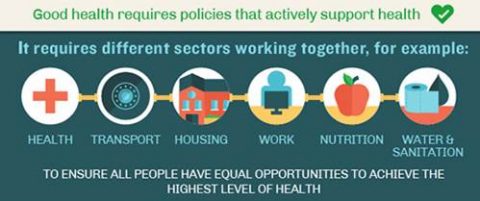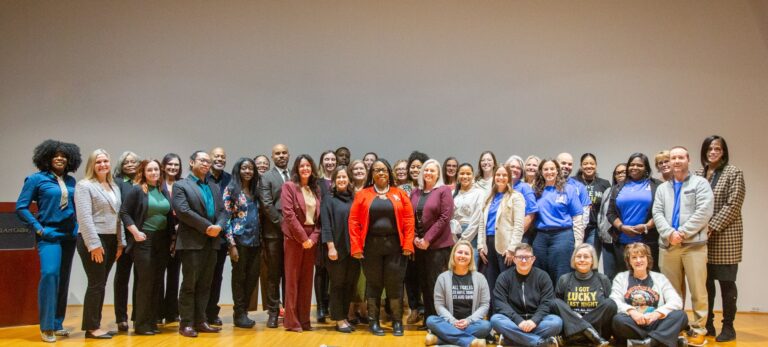Our individual behaviors, as well as social and environmental factors, play a significant role in determining our health.
That is why the Health Foundation for Western and Central New York is engaging leaders in our community to discuss how we can support New York State Governor Andrew Cuomo’s vision to advance a Health Across All Policies approach throughout the state.
Closely aligned with our foundation’s mission to improve the health of young children and older adults, Health Across All Policies asks non-health sectors such as transportation, housing and energy to build health considerations, particularly social determinants of health, into their plans and budgets.
Greg Olsen, director of the New York State Office for the Aging, and Paul Beyer, state director of smart growth planning for the New York Department of State, shared information about Health Across All Policies and the state’s plans to bring this effort to communities across New York with a small group of representatives from health systems, non-profits and county agencies, as well as elected officials and other foundations at a May 10 discussion hosted by the Health Foundation.
Olsen and Beyer noted that while the long-term goal is to embed Health in all Policies into all aspects of government, a key part of the Health Across All Policies initiative is establishing a healthy aging framework that will shape the state’s next Prevention Agenda and help New York become the nation’s first age-friendly state.
The Prevention Agenda is New York’s public health improvement plan for improving health and reducing health disparities across the state through an increased emphasis on prevention. It is one of the best barometers of improvement in the health of New Yorkers and it has gotten results. Since 2014, the Prevention Agenda has shown substantial progress across 96 measures of public health and prevention – meeting and exceeding goals in several areas.
For the next six years, the Prevention Agenda will focus on healthy aging. It’s important to remember that age-friendly means communities and policies support people of all ages, from birth to death.
Healthy, age-friendly community design links the traditional concepts of planning (such as land use, transportation, community facilities, parks, and open space) with health themes (such as physical activity, public safety, healthy food access, mental health, air and water quality, and social equity issues).
It’s about smart growth and creating complete communities in urban, suburban and rural areas that are supportive, inclusive, accessible and interesting places to all people regardless of age, race, immigrant status or ability.
What’s good for people over 60 is good for millennials, and age-friendly communities are communities that are great places to live for anyone, at any age.
That being said, with half of New York’s residents over the age of 45, Olsen emphasized that we cannot continue to think that older adults aren’t a vital part of our society.
While it’s true that older adults may have health challenges, they also contribute to the state’s economy:
- 935,000 individuals age 55+ contribute 495 million hours of service at economic value of $13.8 billion
- 64% of individuals age 60+ who own their own homes have no mortgage
- 1 million caregivers at any time in a year provide $32 billion worth of care to their families, friends and neighbors. ; a caregiver’s average age is 64
- spending by people aged 50 and over in the US in 2015 supported:
- more than 89.4 million jobs
- more than $4.7 trillion in labor income.
- 61 percent of all U.S. jobs and 43 percent of labor income was related to spending by the 50-plus cohort.
To stay economically competitive, the health and wellbeing of all citizens is essential.
Moving forward, Olsen and Beyer said that 12 state agencies are currently identifying existing and proposed state level initiatives that support Health Across All Policies and Healthy Aging. They will then work to identify ways that they can strengthen state-level initiatives and investments and provide incentives for implementing low-cost projects that can have a big impact.
Collaboration at the local level will amplify that impact. Health Across All Policies represents a sea change, and with such an ambitious plan, we need many organizations working on multiple fronts to improve the health of New Yorkers.
At the Health Foundation, we are currently partnering with New York State, AARP and other livability advocates to support Health Across All Policies, including hosting a pre-summit intensive at AARP’s second annual Leading on Livability Summit August 1-3, 2018 at the Crowne Plaza in Syracuse, NY.
This pre-summit intensive will offer participants a unique opportunity to sharpen their approach to community engagement. The pre-summit will take place August 1-2, 2018, also at the Crowne Plaza. To learn more, click here.
Registration and lodging details will hit your inbox in the next few weeks, so mark your calendar for this event now!



